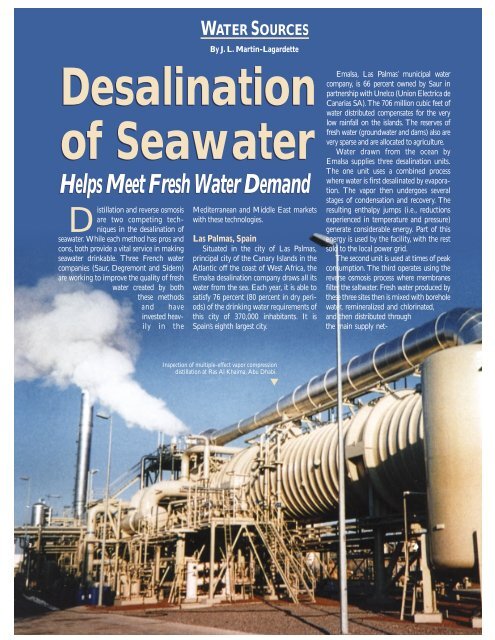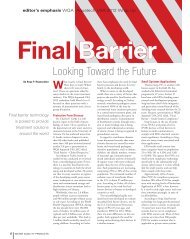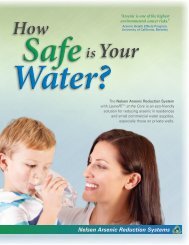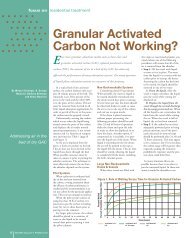Desalination of Seawater Desalination of Seawater - Water Quality ...
Desalination of Seawater Desalination of Seawater - Water Quality ...
Desalination of Seawater Desalination of Seawater - Water Quality ...
Create successful ePaper yourself
Turn your PDF publications into a flip-book with our unique Google optimized e-Paper software.
WATER SOURCES<br />
By J. L. Martin-Lagardette<br />
<strong>Desalination</strong><br />
<strong>of</strong> <strong>Seawater</strong><br />
Helps Meet Fresh <strong>Water</strong> Demand<br />
Distillation and reverse osmosis<br />
are two competing techniques<br />
in the desalination <strong>of</strong><br />
seawater. While each method has pros and<br />
cons, both provide a vital service in making<br />
seawater drinkable. Three French water<br />
companies (Saur, Degremont and Sidem)<br />
are working to improve the quality <strong>of</strong> fresh<br />
water created by both<br />
these methods<br />
and have<br />
invested heavily<br />
in the<br />
Mediterranean and Middle East markets<br />
with these technologies.<br />
Las Palmas, Spain<br />
Situated in the city <strong>of</strong> Las Palmas,<br />
principal city <strong>of</strong> the Canary Islands in the<br />
Atlantic <strong>of</strong>f the coast <strong>of</strong> West Africa, the<br />
Emalsa desalination company draws all its<br />
water from the sea. Each year, it is able to<br />
satisfy 76 percent (80 percent in dry periods)<br />
<strong>of</strong> the drinking water requirements <strong>of</strong><br />
this city <strong>of</strong> 370,000 inhabitants. It is<br />
Spain’s eighth largest city.<br />
Emalsa, Las Palmas’ municipal water<br />
company, is 66 percent owned by Saur in<br />
partnership with Unelco (Union Electrica de<br />
Canarias SA). The 706 million cubic feet <strong>of</strong><br />
water distributed compensates for the very<br />
low rainfall on the islands. The reserves <strong>of</strong><br />
fresh water (groundwater and dams) also are<br />
very sparse and are allocated to agriculture.<br />
<strong>Water</strong> drawn from the ocean by<br />
Emalsa supplies three desalination units.<br />
The one unit uses a combined process<br />
where water is first desalinated by evaporation.<br />
The vapor then undergoes several<br />
stages <strong>of</strong> condensation and recovery. The<br />
resulting enthalpy jumps (i.e., reductions<br />
experienced in temperature and pressure)<br />
generate considerable energy. Part <strong>of</strong> this<br />
energy is used by the facility, with the rest<br />
sold to the local power grid.<br />
The second unit is used at times <strong>of</strong> peak<br />
consumption. The third operates using the<br />
reverse osmosis process where membranes<br />
filter the saltwater. Fresh water produced by<br />
these three sites then is mixed with borehole<br />
water, remineralized and chlorinated,<br />
and then distributed through<br />
the main supply net-<br />
Inspection <strong>of</strong> multiple-effect vapor compression<br />
distillation at Ras Al Khaima, Abu Dhabi.<br />
▲
WATER SOURCES<br />
work. When the project is completed, the<br />
total capacity <strong>of</strong> the site will increase to more<br />
than 3,500 cubic feet <strong>of</strong> water per day.<br />
Palma de Majorca<br />
A little further north in the<br />
Mediterranean, on the island <strong>of</strong> Palma de<br />
Majorca, Degremont Espagne, part <strong>of</strong> the<br />
Suez-Lyonnaise-des-Eaux group, has set up<br />
one <strong>of</strong> the largest desalination plants in<br />
Europe. The Son Tugotes de Palma de<br />
Majorque station processes 1.06 million cubic<br />
feet <strong>of</strong> water per day using reverse osmosis.<br />
After pretreatment by coagulation and filtration,<br />
the water passes through six reverse<br />
osmosis racks containing 2,058 spiral<br />
polyamide modules on two levels. Each is<br />
supplied by a high pressure pump rated at<br />
9,900 cubic feet per hour, at a pressure <strong>of</strong> 362<br />
psi (25 bars). Another station bordering the<br />
sea is nearing completion, and will be able to<br />
treat 1.5 million cubic feet <strong>of</strong> seawater per day.<br />
A Possible Solution for Municipalities<br />
Currently there are 12,500 desalination<br />
plants in the world, supplying 706<br />
million cubic feet per day, or 1 percent <strong>of</strong><br />
the world’s production <strong>of</strong> drinking water.<br />
The reduced cost <strong>of</strong> new desalination<br />
equipment is expected to double the<br />
world market in this field. The market<br />
could reach more than $70 billion over<br />
the next twenty years. Over the next five<br />
years, $10 billion already has been earmarked<br />
for the installation <strong>of</strong> desalination<br />
units throughout the world, which<br />
will achieve a production rate <strong>of</strong> 187 million<br />
cubic feet per day. These figures, calculated<br />
by Vivendi, take into account<br />
chronic water shortages in various countries<br />
around the world and the growing<br />
requirements in hot countries such as the<br />
Middle East, Asia and the Caribbean.<br />
Sidem specializes in water desalination<br />
using a thermal process. The company<br />
ranks second in the world in this field,<br />
treating around 43 million cubic feet <strong>of</strong><br />
water per day. The company has supplied<br />
450 installations for more than twenty five<br />
years. Employing eighty people, it has a<br />
permanent <strong>of</strong>fice in Abu Dhabi in the<br />
United Arab Emirates and another in<br />
Tripoli, Libya, as well as a subsidiary in the<br />
Caribbean, Ucdem. The company generates<br />
sales <strong>of</strong> $54 million per year.<br />
Sidem supplies two types <strong>of</strong> equipment:<br />
distillation plants that use the<br />
process <strong>of</strong> successive expansions known<br />
as multi-flash and units using multiple<br />
effect distillation (MED) with or without<br />
vapor compression.<br />
In the multi-flash system, seawater is<br />
circulated through a series <strong>of</strong> cells at successively<br />
lower pressures. As it passes<br />
through each cell, the water releases the<br />
quantity <strong>of</strong> vapor necessary to reestablish<br />
equilibrium with the pressure in the cell.<br />
This technology makes it possible to build<br />
large installations, but its energy balance is<br />
not truly optimized.<br />
In the MED process, several evaporator-condensers<br />
are installed in series. In<br />
this way, the latent heat <strong>of</strong> condensation<br />
is reused several times. The development<br />
<strong>of</strong> this technique was for a long time limited<br />
by problems with the build-up <strong>of</strong><br />
scale. Today, the restricting <strong>of</strong> water temperature<br />
to 149° F, the size <strong>of</strong> the installa-<br />
www.waterinfocenter.com<br />
WATER Engineering & Management • APRIL 2001 19
WATER SOURCES<br />
tions and new anti-scaling products have overcome<br />
this problem. Sidem’s MED now is reaching a unit<br />
capacity <strong>of</strong> 812,000 cubic feet per day.<br />
There are two main competing techniques for the<br />
desalination <strong>of</strong> seawater: thermal techniques such as<br />
distillation and membrane techniques such as reverse<br />
osmosis. MED, especially coupled to a compressor,<br />
<strong>of</strong>ten has cheaper capital and operating costs as well as<br />
good reliability. In addition, the system does not<br />
require a high quality water supply resulting in less<br />
treatment before operation.<br />
Reverse osmosis, a technique in which water is<br />
forced through semi-permeable membranes,<br />
requires pre-treatment to eliminate particles in suspension.<br />
On the other hand, it has less negative<br />
environmental impact than with MED. The success<br />
<strong>of</strong> this technique is due to the modular nature <strong>of</strong> its<br />
production and the fact that it is compact and easily<br />
automated, while <strong>of</strong>fering good energy efficiency.<br />
▲<br />
1.5 million cubic feet <strong>of</strong> water<br />
per day is treated by this<br />
reverse osmosis desalination plant.<br />
▲<br />
An Energy-Saving Condenser<br />
Evaporating seawater takes a lot <strong>of</strong> energy. In order<br />
to evaporate one kilogram <strong>of</strong> water, it takes 540 kilocalories.<br />
The first evaporation and condensation systems<br />
used for desalination only used a small part <strong>of</strong> the<br />
energy consumed during treatment. Improvements to<br />
the process have tried to take advantage <strong>of</strong><br />
this heat.<br />
Recently, a team from the Chemical<br />
Engineering Sciences Laboratory at<br />
CNRS (National Center for Scientific<br />
Research), together with the International<br />
<strong>Water</strong> Center developed a falling-film<br />
plate evaporator-condenser that is energy<br />
efficient. Its simple design consists <strong>of</strong> two<br />
metal plates 6.6 feet high and 3.3 feet<br />
wide, spaced three-quarters <strong>of</strong> an inch<br />
apart by a polypropylene frame. The film<br />
<strong>of</strong> seawater falling onto the evaporator<br />
plate is warmed by the latent heat released<br />
by the neighboring condenser.<br />
This new distillation process enables<br />
the production <strong>of</strong> nearly seven gallons <strong>of</strong><br />
fresh water per hour, with an evaporation<br />
rate <strong>of</strong> 10 to 50 percent <strong>of</strong> the seawater.<br />
Modular and easy to assemble, it can be<br />
operated by unskilled workers. The Altran<br />
foundation for innovation awarded the<br />
company its 1999 European grand prix for<br />
this process.<br />
About the author:<br />
J.L. Martin-Lagardette is a free-lance environmental<br />
writer in Paris, France.<br />
For more information on this subject,<br />
circle 868 on the reader service card.<br />
20 WATER Engineering & Management • APRIL 2001<br />
www.waterinfocenter.com





